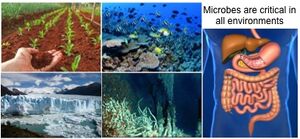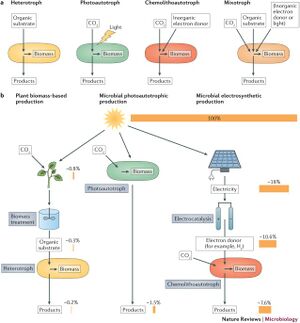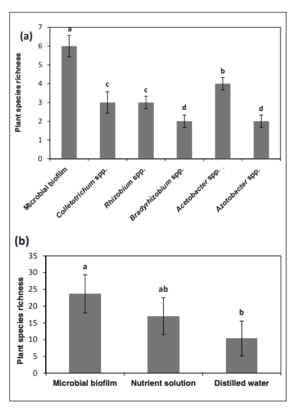The effects of microbial biodiversity on ecosystem function in response to climate change: Difference between revisions
No edit summary |
No edit summary |
||
| Line 32: | Line 32: | ||
[[Image:Screenshot.png|thumb|300px|right|This image shows the results of a 2017 study examining the effects of fungal-bacterial biofilm on subsequent biodiversity in the restoration of a degraded tea land. [https://jnsfsl.sljol.info/articles/abstract/10.4038/jnsfsr.v45i4.8226/]] | [[Image:Screenshot.png|thumb|300px|right|This image shows the results of a 2017 study examining the effects of fungal-bacterial biofilm on subsequent biodiversity in the restoration of a degraded tea land. [https://jnsfsl.sljol.info/articles/abstract/10.4038/jnsfsr.v45i4.8226/]] | ||
As mentioned previously, current agricultural practices contribute a large amount of greenhouse gasses and other pollutants into the environment, accelerating the increase of climate change and subsequent biodiversity loss worldwide. In 2015, the Environmental Protection Agency (EPA) estimated that 22.0 million tons of fertilizers were used for agricultural practices in the United States alone. This influx of fertilizer results from an increased need for crop yields with a growing population, and a history of unsustainable practices, such as monoculture, depleting the nutrient-rich topsoil. However, despite the intention, long-term application of fertilizers can lead to groundwater contamination through nitrate formation. This occurs due to the fact that inorganic nitrogen fertilization results in between 24-82% of the total nitrogen being lost through leaching or ammonia volatilization. Given the ineffectiveness of our current practices, alternative methods for agriculture are needed as the current methods contaminate the surrounding environment and release large quantities of greenhouse gasses, furthering climate change. <br> | As mentioned previously, current agricultural practices contribute a large amount of greenhouse gasses and other pollutants into the environment, accelerating the increase of climate change and subsequent biodiversity loss worldwide. In 2015, the Environmental Protection Agency (EPA) estimated that 22.0 million tons of fertilizers were used for agricultural practices in the United States alone. <ref> [https://cfpub.epa.gov/ U. S epa web server. (n.d.). Retrieved April 15, 2022, from ] </ref> This influx of fertilizer results from an increased need for crop yields with a growing population, and a history of unsustainable practices, such as monoculture, depleting the nutrient-rich topsoil. However, despite the intention, long-term application of fertilizers can lead to groundwater contamination through nitrate formation. <ref name=Zhao> [https://doi.org/10.1016/j.njas.2011.09.004 Zhao, B. Q., Li, X. Y., Liu, H., Wang, B. R., Zhu, P., Huang, S. M., Bao, D. J., Li, Y. T., & So, H. B. (2011). Results from long-term fertilizer experiments in China: The risk of groundwater pollution by nitrate. NJAS - Wageningen Journal of Life Sciences, 58(3), 177–183. ] </ref> This occurs due to the fact that inorganic nitrogen fertilization results in between 24-82% of the total nitrogen being lost through leaching or ammonia volatilization. <ref name=Zhao/> Given the ineffectiveness of our current practices, alternative methods for agriculture are needed as the current methods contaminate the surrounding environment and release large quantities of greenhouse gasses, furthering climate change. <br> | ||
<br> Microbes have been associated with plants through multiple communication systems through millions of years of evolution. Given this interconnected evolution, various microbes have become extremely efficient in decomposition, controlling pathogens, reducing greenhouse gasses, and supporting entire ecosystems through recycling key nutrients. <br> | <br> Microbes have been associated with plants through multiple communication systems through millions of years of evolution. Given this interconnected evolution, various microbes have become extremely efficient in decomposition, controlling pathogens, reducing greenhouse gasses, and supporting entire ecosystems through recycling key nutrients. <br> | ||
Revision as of 17:20, 15 April 2022
Introduction
By Isaac Johnson

Throughout the world, microbes in various ecosystems perform a vast array of different functions that are crucial to the maintenance of the respective environments. For example, in some nutrient-poor ecosystems, nitrogen-fixing bacteria and mycorrhizal fungi are responsible for providing the plants up to 80% of their total nitrogen, and 75% of their total phosphorus annually. [1] Further, our own bodies rely on microbial symbionts in order to provide us with necessary nutrients, direct our immune systems, and stabilize our gut microbiome with antimicrobial activities. [2] Surveys of any global ecosystem will demonstrate the importance of the microbiome on the functionality of that ecosystem.
Currently, warming due to anthropogenic activities has occurred in every single global region over the past century, with current temperatures and CO2 levels that would have been considered extreme in the mid-twentieth century. [3] This atmospheric accumulation of CO2 has driven the current global temperatures upwards, and forced ecosystems to function at evolutionarily non-optimal temperatures. However, microbes are able to mitigate some of these effects through various mechanisms. For example, under extreme temperature conditions, endoliths provided a temperature buffer of between 1.7°C and 4.8°C, and, when present, prevented mass mussel mortality in a 2018 heatwave near the coast of the English Channel. [4]
While microbes can serve as mitigators of global climate change, they can also serve to accelerate the aforementioned changes in the biosphere. Microbial respiration is a major contributor to global carbon levels due to the ability of microbes to decompose organic matter and release CO2 as a waste product. [5] Additionally, there is an entire group of microbes called methanogens who produce methane (CH4) as a product of their metabolism. [6] While this production of methane could be used as a potential fuel source through anthropogenic manufacturing, the natural metabolism of methane is dangerous to climate change, as methane has a global warming potential roughly 25 times greater than CO2. [7]
In addition to playing a crucial role in natural ecosystems, agricultural ecosystems are equally as reliant on microbial interactions. The agricultural industry currently produces about 47% of total methane emissions and 58% of total nitrous oxide emissions. [8] The massive effects of this industry are only going to increase as the global population is expected to increase by ⅓ to 10 billion in the year 2050, forcing our agricultural production to increase by 60% to meet the demand for food to sustain a population of that size. [9] This example demonstrates the profound need for more sustainable anthropogenic practices, as well as a better understanding of microbes to promote healthier ecosystem functioning.
We have already seen that microbes have various crucial roles in different ecosystems, however, microbial biodiversity and not just microbial presence is a key component of maintaining healthy ecosystem functioning. Due to the wide range of different metabolism as well as the numerous environmental niches for microbes, microbial biodiversity is critical in the maintenance of a healthy ecosystem, and is easily accomplished due to seemingly redundant “cryptic” species of microbes. [10] Further, under realistic scenarios of climate change, this seeming redundancy has been shown to be functionally unique, as interspecific complementation increased under thermal stress. [11] Overall, this shows how the large amounts of biodiversity observed within the microbial world could prove important in maintaining ecosystem functioning with increased climate change.
Given the importance of diverse microbial interactions on ecosystem stability, microbial communities could have far reaching effects on climate change in ecosystems across the globe. It has been forecasted that under scenarios of climate change, there will be directional selection for warm-tolerant organisms and rapid migration events, all of which will contribute to widespread losses in biodiversity. [12] The following examination of projected climate effects and diverse microbial communities will allow us to understand the problems and strategies for mitigation of the current situation.
Microbial Biodiversity in Natural Ecosystems

Overall biodiversity is often a key consideration in the maintenance of a healthy ecosystem, however, microbial biodiversity takes this notion to the extreme. In plants and animals, there is typically a positive but decreasing relationship between biodiversity and ecosystem functioning (BEF). [13] The decreasing slope of this relationship is due to the organismal functional redundancy that exists in these ecosystems (certain organisms providing the same service to the ecosystem). However, in terms of microbes, the BEF relationship reveals that with decreased microbial diversity, there are decreases in both general and specialized functioning in every examined scenario. [13] This serves to indicate that there is limited functional redundancy in microbial communities, and there are numerous critical niches filled by vastly different species. Overall, the array of niches filled by specific microbes is unsurprising given that bacteria is the oldest as well as the most diverse domain of life. [14] Understanding what these niches are and how they are filled in an ecosystem is critical to understanding the importance of diverse microbial communities.
Microbes are able to metabolize numerous different substrates in order to generate energy. One of the most important areas in which this metabolism occurs is through cyanobacterial autotrophy. Cyanobacteria and chloroplasts (which evolved as eukaryotic endosymbionts from cyanobacteria) are the only two sources of life that produce oxygen gas through the capture of solar radiation. [15] Given the reliance of a large percentage of organisms on oxygen in order to respire, as well as the fact that autotrophic primary production supports all life, this is a vital niche in our biosphere. However, autotrophic cyanobacteria are only the tip of the iceberg in terms of microbial respiration. Some lithotrophic microbes use inorganic electron donors to generate energy, while other microbes have the ability to ferment substrates, and others use combinations of multiple types of catabolism. [15] Overall, the ability of these diverse organisms to use different substrates to yield different products under variable environmental conditions is the reason why they are so vital to the stability of ecosystems. Furthermore, microbes not only have the ability to use variable substrates, they can also remove toxins from the environment. An example of this comes from petroleum, which can be used by over 79 different genera of bacteria that are capable of using petroleum (an environmental contaminant) as a substrate for metabolism. [16] These variable methods of catabolism exhibited by different species cycle various important minerals and nutrients and showcase the importance of microbes in numerous different niches.

In addition to diverse catabolism to cycle nutrients, one of the other key roles of microbes in an ecosystem is the diverse and specific symbiotic relationships formed with various different species of plants, animals, and other microbes. Recent research has found that symbiosis is the central driver of all evolution across the entire tree of life, demonstrating the profound importance of these interactions. [17] One of the most well-studied examples of this type of symbiosis is between legumes and nitrogen-fixing bacteria. A 2006 study showed that three out of four experimental species of legumes required the presence of nitrogen-fixing rhizobia in order to successfully grow in the presence of other plant species. [18] While many plants require similar symbiotic relationships in order for proper growth, numerous animal species are also reliant on diverse microbial symbionts in order for proper functioning. Similarly to humans, some ants have been shown to exist with various gut microbes that are able to influence the behavior of their host and provide nutrients in return. [19] This association between ants and their microbiota has also been shown to have evolved numerous times throughout the course of their evolutionary history showing the specificity of these interactions. [19] These examples are only a few of the many diverse symbiotic relationships that microbes form with different species. From these examples, it becomes clear that a wide array of specific interactions occur between microbes and other organisms, and that these interactions have evolved many times in tandem with one another, revealing another reason why wide microbial biodiversity is necessary to support a functioning organismal ecosystem.
Anthropogenic Ecosystems and Microbial Biodiversity
Agriculture

As mentioned previously, current agricultural practices contribute a large amount of greenhouse gasses and other pollutants into the environment, accelerating the increase of climate change and subsequent biodiversity loss worldwide. In 2015, the Environmental Protection Agency (EPA) estimated that 22.0 million tons of fertilizers were used for agricultural practices in the United States alone. [20] This influx of fertilizer results from an increased need for crop yields with a growing population, and a history of unsustainable practices, such as monoculture, depleting the nutrient-rich topsoil. However, despite the intention, long-term application of fertilizers can lead to groundwater contamination through nitrate formation. [21] This occurs due to the fact that inorganic nitrogen fertilization results in between 24-82% of the total nitrogen being lost through leaching or ammonia volatilization. [21] Given the ineffectiveness of our current practices, alternative methods for agriculture are needed as the current methods contaminate the surrounding environment and release large quantities of greenhouse gasses, furthering climate change.
Microbes have been associated with plants through multiple communication systems through millions of years of evolution. Given this interconnected evolution, various microbes have become extremely efficient in decomposition, controlling pathogens, reducing greenhouse gasses, and supporting entire ecosystems through recycling key nutrients.
Given these key ecosystem responsibilities of diverse microbial communities, it is gravely concerning that modern agricultural practices are degrading the existing biodiversity. However, there are many innovative new techniques emerging aimed at the sustainable continuation of agricultural practices with a focus on restoring biodiversity to our depleted soils. One of these strategies is the application of fungal-bacterial biofilms (FBB). When soil was treated with FBB compared to fungal and bacterial monocultures, significantly higher species richness was observed, higher yields, increased stress tolerance, as well as increased nitrogen fixation were observed. These results demonstrate that harboring diverse microbial communities increases the overall production and richness of agricultural ecosystems that have been depleted of nutrients. This serves as a model for potential future remediation as our current practices continue to degrade the existing biodiversity in our soil globally.
Health
Section 3
Include some current research, with at least one figure showing data.
Section 4
Conclusion
References
- ↑ van der Heijden, M. G. A., Bardgett, R. D., & van Straalen, N. M. (2008). The unseen majority: Soil microbes as drivers of plant diversity and productivity in terrestrial ecosystems. Ecology Letters, 11(3), 296–310.
- ↑ Martín, R., Miquel, S., Ulmer, J., Langella, P., & Bermúdez-Humarán, L. g. (2014). Gut ecosystem: How microbes help us. Beneficial Microbes, 5(3), 219–233.
- ↑ Estrada, F., Kim, D., & Perron, P. (2021). Anthropogenic influence in observed regional warming trends and the implied social time of emergence. Communications Earth & Environment, 2(1), 1–9.
- ↑ Zardi, G. I., Monsinjon, J. R., McQuaid, C. D., Seuront, L., Orostica, M., Want, A., Firth, L. B., & Nicastro, K. R. (2021). Foul‐weather friends: Modelling thermal stress mitigation by symbiotic endolithic microbes in a changing environment. Global Change Biology, 27(11), 2549–2560.
- ↑ Mohanty, S., & Swain, C. K. (2018). Role of microbes in climate smart agriculture. In D. G. Panpatte, Y. K. Jhala, H. N. Shelat, & R. V. Vyas (Eds.), Microorganisms for Green Revolution: Volume 2: Microbes for Sustainable Agro-ecosystem (pp. 129–140). Springer.
- ↑ Enzmann, F., Mayer, F., Rother, M., & Holtmann, D. (2018). Methanogens: Biochemical background and biotechnological applications. AMB Express, 8, 1.
- ↑ Mohanty, S., & Swain, C. K. (2018). Role of microbes in climate smart agriculture. In D. G. Panpatte, Y. K. Jhala, H. N. Shelat, & R. V. Vyas (Eds.), Microorganisms for Green Revolution: Volume 2: Microbes for Sustainable Agro-ecosystem (pp. 129–140). Springer.
- ↑ Mohanty, S., & Swain, C. K. (2018). Role of microbes in climate smart agriculture. In D. G. Panpatte, Y. K. Jhala, H. N. Shelat, & R. V. Vyas (Eds.), Microorganisms for Green Revolution: Volume 2: Microbes for Sustainable Agro-ecosystem (pp. 129–140). Springer.
- ↑ S., & Swain, C. K. (2018). Role of microbes in climate smart agriculture. In D. G. Panpatte, Y. K. Jhala, H. N. Shelat, & R. V. Vyas (Eds.), Microorganisms for Green Revolution: Volume 2: Microbes for Sustainable Agro-ecosystem (pp. 129–140). Springer.
- ↑ Finlay, B. J., Maberly, S. C., & Cooper, J. I. (1997). Microbial diversity and ecosystem function. Oikos, 80(2), 209–213.
- ↑ García, F. C., Bestion, E., Warfield, R., & Yvon-Durocher, G. (2018). Changes in temperature alter the relationship between biodiversity and ecosystem functioning. Proceedings of the National Academy of Sciences, 115(43), 10989–10994.
- ↑ Bellard, C., Bertelsmeier, C., Leadley, P., Thuiller, W., & Courchamp, F. (2012). Impacts of climate change on the future of biodiversity. Ecology Letters, 15(4), 365–377.
- ↑ 13.0 13.1 Delgado‐Baquerizo, M., Giaramida, L., Reich, P. B., Khachane, A. N., Hamonts, K., Edwards, C., Lawton, L. A., & Singh, B. K. (2016). Lack of functional redundancy in the relationship between microbial diversity and ecosystem functioning. Journal of Ecology, 104(4), 936–946.
- ↑ Vitorino, L. C., & Bessa, L. A. (2018). Microbial diversity: The gap between the estimated and the known. Diversity, 10(2), 46.
- ↑ 15.0 15.1 Slonczewski, J., Foster, J. W., & Zinser, E. R. (2020). Microbiology: An evolving science (Fifth edition, international student edition). W.W. Norton & Company.
- ↑ Xu, X., Liu, W., Tian, S., Wang, W., Qi, Q., Jiang, P., Gao, X., Li, F., Li, H., & Yu, H. (2018). Petroleum hydrocarbon-degrading bacteria for the remediation of oil pollution under aerobic conditions: A perspective analysis. Frontiers in Microbiology, 9.
- ↑ Raina, J.-B., Eme, L., Pollock, F. J., Spang, A., Archibald, J. M., & Williams, T. A. (2018). Symbiosis in the microbial world: From ecology to genome evolution. Biology Open, 7(2), bio032524.
- ↑ van der Heijden, M. G. A., Bakker, R., Verwaal, J., Scheublin, T. R., Rutten, M., van Logtestijn, R., & Staehelin, C. (2006). Symbiotic bacteria as a determinant of plant community structure and plant productivity in dune grassland. FEMS Microbiology Ecology, 56(2), 178–187.
- ↑ 19.0 19.1 Moreau, C. S. (2020). Symbioses among ants and microbes. Current Opinion in Insect Science, 39, 1–5.
- ↑ U. S epa web server. (n.d.). Retrieved April 15, 2022, from
- ↑ 21.0 21.1 Zhao, B. Q., Li, X. Y., Liu, H., Wang, B. R., Zhu, P., Huang, S. M., Bao, D. J., Li, Y. T., & So, H. B. (2011). Results from long-term fertilizer experiments in China: The risk of groundwater pollution by nitrate. NJAS - Wageningen Journal of Life Sciences, 58(3), 177–183.
Authored for BIOL 238 Microbiology, taught by Joan Slonczewski, 2022, Kenyon College
